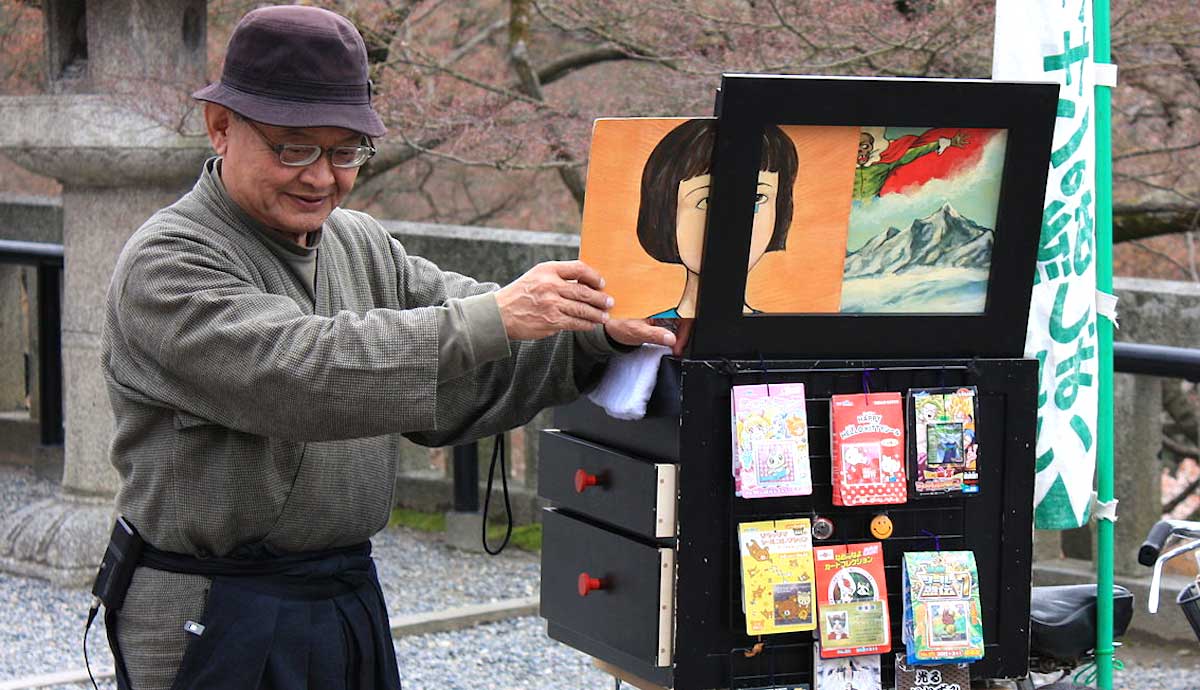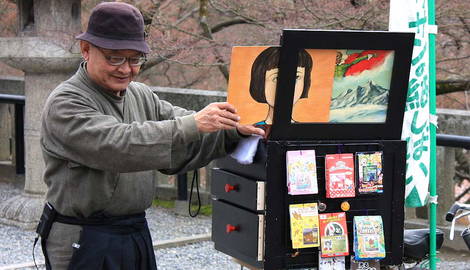
The story of Kamishibai, or “paper plays,” in history starts as a product of innovation as performers cut pages out of children’s novels to tell their narratives. This medium quickly came into vogue as it tapped into a widely untouched demographic in the entertainment sector: children. Using popular culture references and candy to entice them, children impatiently awaited the next installment. This fueled the growth of Kamishibai while keeping it alive despite the economic recession and war. In the 60s, the hopeful story of Kamishibai quickly turned tragic as modern technology and video killed the Kamishibai star. Hope still remains as this unique cultural heritage has become popular in cultural centers and contemporary classrooms in many countries throughout the world.
Kamishibai? Never Heard of It!

Kamishibai (paper drama or paper play) is an innovative type of Japanese theater performance that utilizes story-telling and illustration cards to perform a narrative. This entertainment medium uses between 10 and 30 cardboard cards for one complete play or an episode of a serialized story. The cards are a standard size, about 16 inches by 12 inches (40cm x 30cm). These dimensions allowed the cards to fit comfortably into the Butai or the wooden stage attached to the back of the narrator’s bike.
To perform, the cards were first loaded into the Butai. The narrator would clack his Hyoshiki together to signal the children that he had arrived. Once the audience was seated, the performance commenced. One by one, each illustration slid out from the front and into the back of the stage, revealing the next scene. The dialogue and narration cues for the next card would be written on the back of the illustration that was removed, as seen in the next image, allowing the performer to have the script at hand when delivering the story.

These performances took place on the streets and were created for the gaze of Japanese children, directly targeting the previously untapped younger audiences. Because this form originated for children, the stories were often malleable and modified depending on the audience’s tastes throughout its history on the streets. The Kamishibai man would add jokes, puns, popular culture references, advertising jingles, and sound effects utilizing portable objects and instruments to enhance the viewing experience. Some portable instruments included drums, Hyoshiki, whistles, and even pots and pans, essentially anything portable, since he had to carry these objects with him on his bike.
The Origin of Paper Plays In Japan

The exact origin date of Kamishibai is largely unknown. Debates among scholars about what constitutes “Kamishibai” versus the forms seen as predecessors to the craft add to the ambiguity of its origin. Several men toured neighborhoods in 1928, utilizing illustrations removed from children’s picture books to assist in the visual aspect of their narratives. This is unanimously dubbed the early version of modern Kamishibai. By 1930, Kamishibai transformed, and the stories and illustrated cards were produced and distributed through Kashimoto (literally meaning lenders). The dissemination of these narratives led to the form’s immense popularity. Kashimoto often commissioned stories and illustration cards from professional writers and artists daily, keeping up with the current narrative of their serialized dramas. The hand-painted illustration cards would then be rented out–along with a stage attached to the back of a bike–to the Kamishibai performers.

In the 1930s, the first original Kamishibai play was written and produced, called The Magical Place (Mahou no goten); that same year, The Golden Bat (Ougon Batto) debuted and quickly became the most popular Kamishibai to date. The story of The Golden Bat followed a hero, who appeared to be a skeleton clad in French Renaissance-era clothing, as he defeated a multitude of evil creatures. Due to its success, The Golden Bat was adapted into a Manga series which later inspired a popular animated television show, and eventually, even the production of a live-action movie based on the original storyline came to reality.

The success of Kamishibai in the 1930s is attributed to the economic circumstances of Japan during that time. The stock market crash and subsequent depression in America played a major role in a global recession resulting in mass unemployment and poverty across Japan. During a time when money was tight and jobs were scarce, Kamishibai provided a great way to make a living, as it required little skills and equipment to become a performer. Furthermore, paper plays supplied cheap entertainment to the citizens of Japan when individuals had little expendable income for indulgences and nonessentials.
In 1933, there were approximately 2,000 performers on the streets of Tokyo. This number grew dramatically over the next few years, and by 1937, there were roughly 30,000 performers, who drew an estimated one million audience members daily (See Further Reading, Orbaugh, 2017). This speaks volumes to the enormous popularity of this newly founded art among young children, and this momentum didn’t slow down until the latter half of the 1900s.
War, Propaganda, & Kamishibai, Oh My!

Although the popularity didn’t decrease, after 1937, the number of Kamishibai performers in the streets quickly declined. The war with China, also known as the Second Sino-Japanese War, was officially recognized by the Japanese government. Thus, all able-bodied men performing paper dramas were conscripted into the Japanese army. By 1938, the Japanese government recognized the appeal of Kamishibai and acknowledged the potential for indoctrinating children by producing paper plays that framed their narratives to citizens and imperialized nations in a positive and desirable context. However, the lack of performers made it difficult to circulate the government’s messages. Under these circumstances, the government enlisted women to perform propaganda plays in kindergartens, factories, and neighborhood association meetings.

What We Are Supposed To Do is a wonderful example of propaganda Kamishibai as it pertains to the different roles that every Japanese citizen plays in getting ready for a war on the homefront. The Youth Group play became a popular propaganda tool, perpetuating the narrative that children should love working and learning to better serve as the foundation for the Great East Asia Co-Prosperity Sphere (GEACPS). The Japanese Government utilized the GEACPS to convince Japanese citizens and subjects that Asia would prosper under Japanese rule, leading to a better life and more opportunities without relying on the West.
Once the war concluded, Kamishibai men were back on the streets performing as the lack of formal skills and training–and a multitude of perks–appealed to many war veterans. The benefits of the job enticed many as housing, clothing, and food were provided for the performers during a time when shortages of these commodities were common during the post-war rebuilding efforts. Restored to its original form, Kamishibai abandoned the propaganda plays devised by the Japanese government and returned to its former entertainment-based, light-hearted medium.
Post-War Kamishibai & the End of an Era

Dubbed the “Golden Age of Kamishibai” by many scholars, the 1950s proved to be a time of prosperity for this performing art. During this time, an estimated 50,000 performers were on the streets across Japan, entertaining around five million children daily. During this time, Japan also saw a rise in popular media directed toward children as entertainment radio shows and manga series proliferated at exponential rates, vying for the attention of the youth.
Despite the rise in other entertainment forms, Kamishibai held strong as children still flocked to see the paper plays. Radio and manga heroes such as Batman inspired Kamishibai writers. Writers saw these mediums as an opportunity to create their own spin-off storylines based on popular comics, extending the narratives beyond the radio shows and books to the streets. This proved to be a smart strategic move as Kamishibai remained popular alongside these entertainment media into the 60s.

This decade saw technological advances, worldwide free trade, and a massive economic boom in Japan. This resulted in more discretionary income and thus increased spending on entertainment mediums. At this time, televisions, sometimes called Denki Kamishibai or Electric Kamishibai, integrated into people’s households at alarming rates. Kamishibai struggled to compete with this new, relatively inexpensive form of entertainment that citizens could enjoy from the comfort of their own homes.
Additionally, economic prosperity and low unemployment rates across Japan contributed to the rapid decline of Kamishibai in the 60s. Fewer men were willing to consider a traveling job and inconsistent income as viable options for work, especially considering the tech industry in Japan was rapidly growing with the government’s modernization efforts. By the 1970s, Kamishibai had completely died out from the streets of Japan, leaving behind many joyous memories and nostalgia in the lives of the children that this art touched.

The story of Kamishibai is a tragic tale in which modern technology did away with this entertainment medium; video indeed did kill the Kamishibai star. Currently, Kamishibai is seldom found on the streets in Japan; however, the future remains optimistic as the significance of this unique cultural heritage still lives on in museums, cultural centers, and classrooms across the globe, touching the lives of children even beyond Japan.
Further Reading & Additional Resources:
Hoover Institute Library and Archives. (n.d.). Kamishibai Collection. Fanning the Flames: Propaganda in Modern Japan. https://fanningtheflames.hoover.org/kamishibai-collection
Nash, E. P. (2009). Manga Kamishibai: The art of Japanese paper theater. Abrams Comicarts.
Orbaugh, S. (2017). Kamishibai: The Fantasy Space of the Urban Street Corner. In Freedman, A. (Ed.), Introducing Japanese Popular Culture (pp. ). London: Routledge.
Osaka Prefectural Library International Museum of Children’s Literature. (n.d.). Street Kamishibai Show List by Title. 街頭紙芝居タイトル別一覧. https://www.library.pref.osaka.jp/central/kamishibai/title_index.html








